MSI MPG 321URX QD-OLED
MSRP $950.00
“MSI’s QD-OLED gaming monitor delivers on impeccable image quality while costing less.”
Pros
- Much cheaper than the competition
- Some of the best color we’ve seen
- Extensive list of OLED burn-in prevention features
- 1,000 nits of brightness
- 3-year warranty that covers burn-in
Cons
- A rather bland design
- Limited to USB 2.0 with integrated hub
You could blindly pick any OLED gaming monitor released this year and slap it on the list of the best gaming monitors, and it’d make sense. With a small selection of panels available, basically every OLED gaming monitor looks great. MSI has a very unique take on the growing market of OLED gaming monitors with the MPG 321URX QD-OLED, though, and it has a big edge over the competition when it comes to crowning a winning OLED gaming monitor in 2024.
That all comes down to price. MSI aggressively undercut the competition with the MPG 321URX by anywhere from $250 to $350. I thought that would mean some clear compromises in other areas of the display, but as I quickly learned after unboxing my review unit, that’s simply not the case.

Get your weekly teardown of the tech behind PC gaming
MSI MPG 321URX QD-OLED Specs
| MSI MPG 321URX QD-OLED | |
| Screen size | 32 inches |
| Panel type | Samsung Display QD-OLED |
| Resolution | 3,840 x 2,160 |
| Peak brightness | 1,000 nits (HDR) |
| HDR | DisplayHDR True Black 400 |
| Local dimming | 8,294,400 zones |
| Contrast ratio | 1,500,000:1 |
| Response time | 0.03ms (GtG) |
| Refresh rate | 240Hz |
| Curve | N/A |
| Speakers | N/A |
| Inputs | 2x HDMI 2.1, 1x DisplayPort 1.4a, 1x USB-C w/ 90W power delivery |
| Ports | 2x USB 2.0 Type-A |
| Adjustments | 4.3 inches of height, 20 degrees of tilt, 60 degrees of swivel, 20 degrees of pivot |
| List price | $950 |
Design
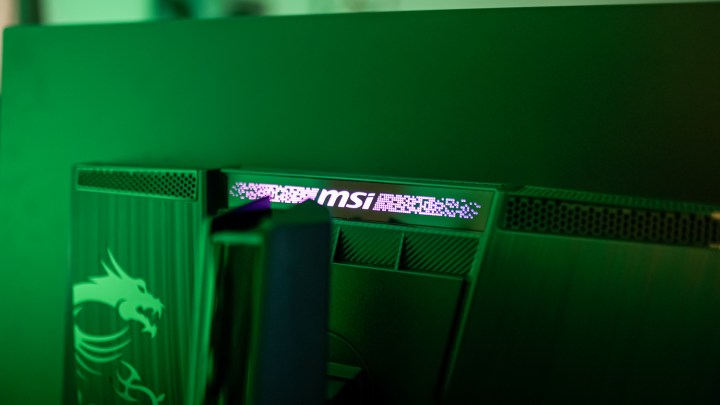
If there’s anywhere the MPG 321URX compromises, it’s the design. It doesn’t look bad, though, just a little bland. The shell is plastic, and from the front, you could confuse the MPG 321URX with any other 32-inch monitor. A highlight is the glossy finish, which is a big upside when combined with an OLED panel underneath.
All of the flair is behind the monitor, but it’s still not much. There’s a faux brushed metal look around the heat sink (it’s still plastic), as well as a glossy MSI dragon logo. There’s also an MSI logo on top on the heat sink that you can control with MSI Mystic Light. It’s small and dim, however, so you’ll never see it while actually using the display.
Pedestrian as the design of the MPG 321URX is, the stand MSI includes is excellent. There’s a routing channel that’s positioned behind the monitor, so there aren’t any dangling cables, and MSI opted for a single square stand, as opposed to the long legs you see on monitors like the Samsung Odyssey Neo G8.

There’s also a wide range of adjustment. You get just over four inches of height adjustment, 20 degrees of tilt and pivot, and a very generous 60 degrees of swivel. You could have the monitor set up in the corner of your desk and adjust the screen just with the included stand. Still, if you need more adjustment, there’s a 100mm x 100mm VESA mount available.
Features

The most direct competition for the MPG 321URX is the Asus ROG PG32UCDM, and the MSI monitor definitely takes a back seat to the Asus display with its set of features. The main feature of the MPG 321URX is the USB-C input that’s capable of 90 watts of power delivery. This is routed into a KVM switch, allowing you to seamlessly use your peripherals across two sources.
There are a couple of caveats, however. MSI only uses USB 2.0 ports. That shouldn’t be a problem for your keyboard and mouse, but it limits the usability of the USB ports for things like your external hard drive or webcam. The USB hub is for your keyboard and mouse, and not much else.
Compared to the Asus competition, MSI is missing a few other features. Most notably, it doesn’t include Black Frame Insertion (BFI), which is one of the key selling points of Asus’ display. On the other hand, MSI includes power delivery with USB-C and a KVM switch, both of which are absent on Alienware’s more expensive take on this panel.
MSI really gains an edge with its OLED prevention features, which I’ll dig into a bit later.
Ports and menu

I appreciate how easy it is to control the MPG 321URX, and that really comes down to how large the on-screen display (OSD) is. It’s big, and a high enough resolution that you’re not squinting as you scroll through the options. This all happens with a joystick around the back of the monitor, but it’s centered, so I never had any trouble finding it. You can also control the monitor with your mouse since you connect the USB-B connection to your PC.
MSI packs in the options, but everything is clearly labeled. You get six color modes tailored for gaming, eight picture modes that can clamp the color to different gamuts, and two HDR modes. Even better, you can access the different color and picture modes with HDR turned on, though you still can’t mess with settings like brightness and contrast with HDR enabled.

For ports, MSI has a standard array. You get two HDMI 2.1 connections, along with a DisplayPort 1.4a port. That means you’ll need to run with Display Stream Compression if you want the full resolution and refresh rate (it’s a lossless compress technique). The HDMI ports also support Variable Refresh Rate (VRR) and downscaling, so they’re perfectly suited for consoles.
The integrated USB hub isn’t as stellar. As mentioned, you have USB-C input with 90W of power delivery and a KVM switch, both of which are great inclusions. The USB-A ports are locked to USB 2.0, however, so you can’t use them for accessories that need a lot of bandwidth like an external hard drive.
Image quality
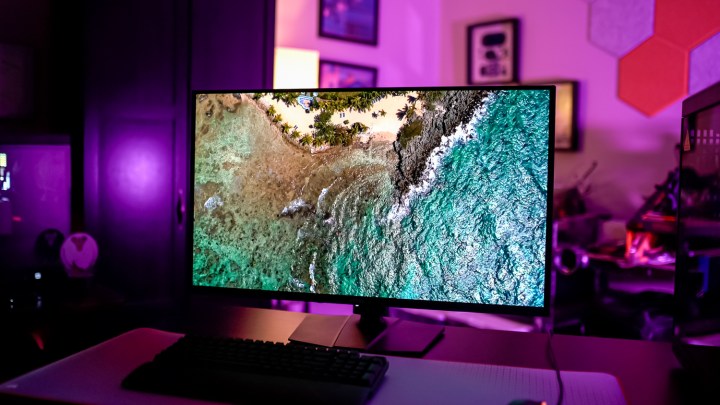
I went into this review a pessimist. Surely, I thought, if MSI was undercutting the competition so much, there would be some sacrifice to image quality. I expected wonky color, disappointing color accuracy, and brightness that missed the mark, not due to the MSI branding, but due to the price. Boy, was I wrong.
The image quality on the MPG 321URX is stunning. It’s just as good as the other monitors we’ve tested using this same panel, and even a bit better than the Asus PG32UCDM with the default settings out of the box. You’re really not giving up anything with this monitor, despite what its price would suggest.
Out of the box, the monitor is tuned to the Eco picture profile with Premium Color as the game mode. This configuration is solid. With it, I measured 100% of sRGB, 87% of AdobeRGB, and 98% of DCI-P3. The Premium Color game mode seems to unlock the full range of color available on the monitor, which means accuracy is a bit off. It’s still not bad, with an average color difference of just 1.37.
MSI includes three modes to clamp the color gamut to sRGB, AdobeRGB, or DCI-P3. With these modes, the color accuracy is excellent: sRGB had the lowest result with an error 0.69, while AdobeRGB had the highest at 0.94 ang DCI-P3 was right in the middle at 0.79. All of these results are fantastic, but it’s interesting to see how the color error scales with the coverage of these different color spaces.
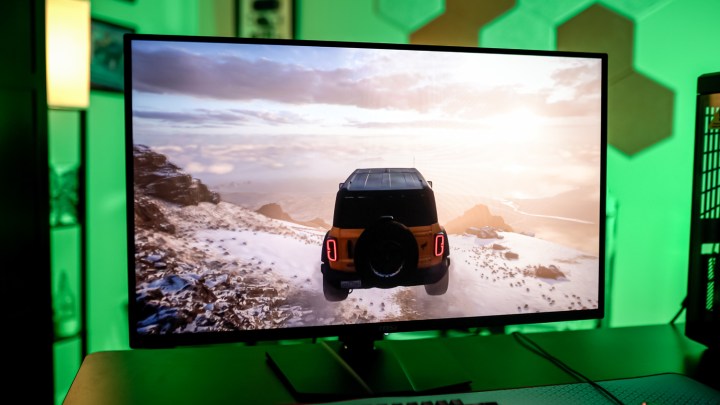
If you’re doing any work on the MPG 321URX, you should do it in SDR. In HDR, the color error was 4.9. That’s because of how brightness works with HDR. The brightness will increase and decrease depending on how much of the screen is filled, so the color error can change quite a bit depending on what’s on-screen. Regardless, HDR looks great, so it’s for media consumption, not creation.
Brightness is on point here, too. This is the same Samsung Display third-gen QD-OLED panel we’ve seen before, and it was able to hit 987 nits of brightness for 1% of the screen in the HDR Peak 1000 mode. That’s typical of what we expect out of this panel, as showcased by monitors like the Alienware 32 QD-OLED.
SDR brightness is still lacking. It topped out at 238 nits, which is a hair below some of the other QD-OLED options. It’s not far behind, but if you’re looking for blistering brightness, HDR is still the way to go with this display.
Gaming
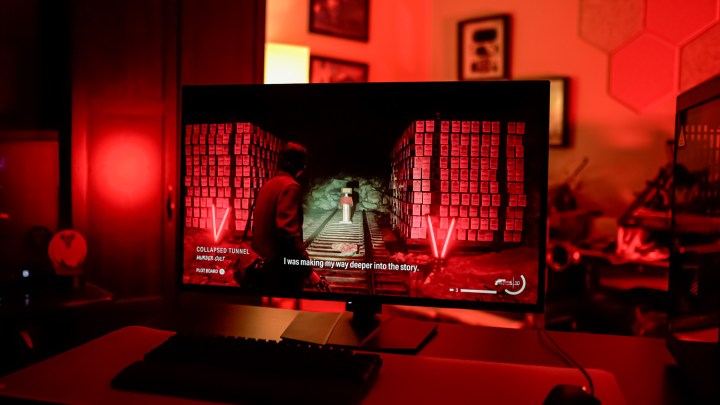
The MPG 321URX is a gaming monster, and you don’t even need to take my word for it. It’s certified with DisplayHDR True Black 400, so you’re getting great HDR performance, and it supports Adaptive Sync, which means you have VRR across both AMD and Nvidia GPUs. That’s not to mention the high 4K resolution and speedy 240Hz refresh rate — this is the peak gaming experience for most people, across both consoles and PC.
Compared to other OLED options, MSI really stands out with its ClearMR 13,000 certification. This is a relatively young standard that tests and validates motion clarity, and MSI is topping the charts here. The 13,000 tier is the highest available — so high, in fact, that it wasn’t even available when ClearMR launched about a year-and-a-half ago. Due to the high refresh rate and low response times of OLED, most gaming displays could earn this certification, and some, such as LG’s panels, already have. It’s still nice to see MSI go out of its way to put a stamp of approval on its high-end gaming monitor, though.
As far as actually using the monitor for gaming, there isn’t much more to say. We’ve seen this panel before and the amazing gaming experience it offers, and MSI lives up to that standard. The HDR experience stands out the most, adding a ton of depth and immersion to games like Cyberpunk 2077 and Alan Wake 2.
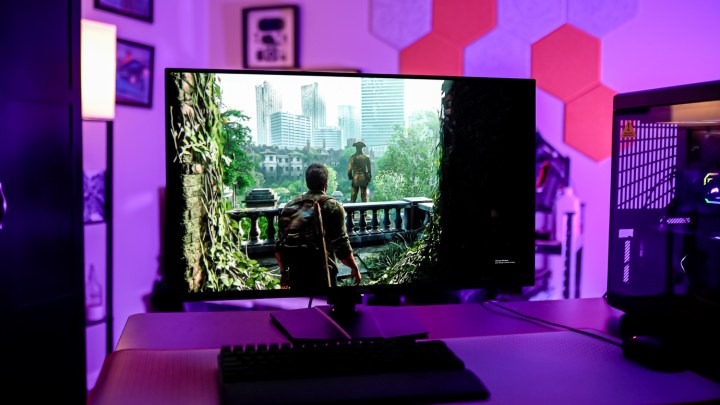
These games shine all the more on a large, 4K display like the MPG321URX. The detail is unmatched, and with the third-gen QD-OLED panel, you don’t get the color fringing on fine details that you saw on some earlier QD-OLED monitors like the Alienware 34 QD-OLED. The main downside is that you’ll need a powerful PC to run this display — with a 240Hz refresh rate, 4K resolution, and large size, you can’t really afford to run games at a lower resolution without sacrificing the experience.
There’s a definite upside for consoles here, both due to the 120Hz mode and the ability to downscale to 1440p through the HDMI ports. MSI supports picture-in-picture and picture-by-picture modes, but the console experience is so great because it neatly fits on a 16:9, 4K display with HDMI 2.1 at the helm.
On the PC side, competitive games also get a boost with the great motion clarity of OLED. For me, the cinematic experience is why you go with an OLED monitor, but the low response times and 240Hz refresh rate definitely provide a boost when you want to squeeze in a few rounds of Valorant or Fortnite.
Warranty and burn-in
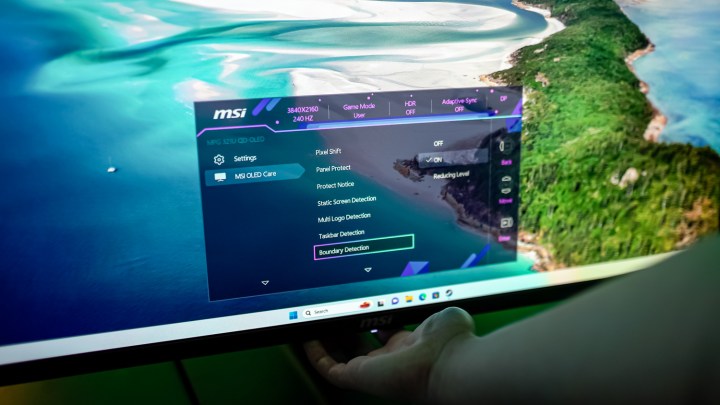
MSI has upped its warranty game a lot. Like Alienware, Corsair, and now Asus, you get three years of coverage on this monitor that includes burn-in. For MSI, that means a luminance of less than or equal to 3.5% at 50% gray with the peak HDR Mode. I doubt you’ll ever get there in three years, as MSI includes one of the most comprehensive suites of burn-in prevention features money can buy.
The package is called OLED Care 2.0. Like other brands, MSI recommends a Panel Protect cycle to refresh the pixels after four hours of accumulated use. There are a far greater array of options, though. There’s pixel shifting with various speeds, as well as a slew of features that automatically detect and dim static elements on your screen.
There’s multi-logo detection, which will pick up on your HUD in games and reduce their brightness to prevent burn-in. There’s also taskbar detection, which cuts out the Windows taskbar. Perhaps the most important is boundary detection. This automatically adjusts the brightness of boundaries on your screen, such as when you have two windows up at the same time. This is the one area of burn-in that’s most difficult to avoid on a desktop, especially if you usually have multiple windows open.
It’s impossible to say what these features will do after thousands of hours of use. They may add up to make the monitor much less susceptible to burn-in, or they may not move the needle compared to other options; there’s no way to tell without thousands of hours of testing.
Still, MSI definitely includes more prevention features than other brands, specifically targeting critical burn-in risks like window boundaries and the Windows taskbar. These features on their own wouldn’t be enough, but MSI backs it up with a three-year warranty, matching the other options on the market.
Should you buy the MSI MPG 321URX?

I went into this review with low expectations, and I came out pleasantly surprised. MSI is able to match the competition from Asus and Alienware in image quality, support, and display options, all while undercutting the price by anywhere from $250 to $350. The only features you’re giving up are BFI compared to the Asus model and DisplayPort 2.1 compared to the upcoming Gigabyte version. Those are both justified trade-offs given how much cheaper the MSI model is.
The MPG 321URX is an enigma. It doesn’t make sense how it’s priced compared to the competition, especially with the few compromises it makes along the way. Maybe MSI is trying to get a leg up in the hotly competitive OLED market, or maybe other options have just been priced too high all along. It doesn’t really matter — as it stands now, the MPG 321URX is the cheapest way to get an OLED display that’s this high in quality, and it doesn’t give up much to reach its excellent price.
Editors’ Recommendations







